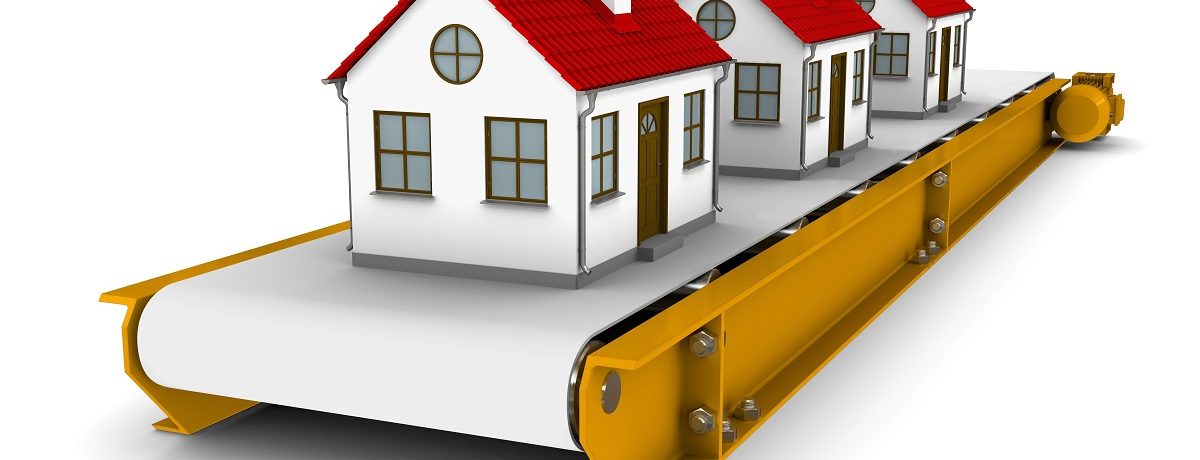Are Modular Homes a Great Opportunity for Rental Property Investors?
Developers still face a tsunami of resistance to building affordably priced homes. Amidst all the distractions, investors, regulators and buyers aren’t seeing perhaps the best solution — modular built homes.
Each spring interest in modular homes rockets (Google Trends). This year, high mortgage rates, labor costs, supply chain issues, high rents, modern amenities, and a strong rental demand may combine to make modular, manufactured homes an enticing prospect for rental property investors.
These new innovations are barely thought of a component of the real estate housing market yet sales growth and large scale developments are enabling this great efficiency of production.
Faster, More Affordable, and Eco-Friendly
This type of construction is quicker, less costly, with fewer highly skilled laborers needed, and involves additional savings from duplication (not customization) of designs and features. Fast indoor fabrication allows faster construction.
If you thought modular are mobile homes, “tiny homes” or boxy prefab cabins, then a new look reveals how beautiful they can be. The phrase “modular homes” has been hijacked by some to sell or rent out mobile homes. They’re not the same.
Check out the models available via Icon Modular homes and how they would appeal to discriminating buyer tastes.
Screenshot courtesy of Icon Modular Homes
Lower cost profiles combined with premium rent price possibilities mean this type of rental property can be much more profitable, and easier for property managers to service. Compare this investment to buying resale homes with their structural, plumbing, wiring, and room/layout issues and making them rent ready.
A New yet Old Trend
Modular homes aren’t really a new trend. In 2021, there were 24,000 total single-family units built using modular (10,000) and panelized/pre-cut (14,000) construction methods, out of a total of 970,000 total single-family homes completed. That was only 2% of the single family construction in 2021, yet in 1998, market share was at 7% according to NAHB’s Eyeonhousing.com’s report.
Back in 2000 and 2011, 5% of multifamily buildings were were modular built (1%) or used panelized construction methods (4%). Today that total is only 1%. The reason for that stat might be that most homes being built are not for the affordable market, and instead are still for the larger, upscale home segment.
The real potential for modular homes are at the lower mid price point. These can garner higher rent prices and deliver higher profit/ROI.
The quality available today might surprise. See this selection of modular homes from various suppliers
Is modular construction about to return big time? There are headwinds in the form of high mortgage rates, yet modular home’s lower price point actually can get a home down into the affordable range for hopeful homeowners. And investors too might be able to finance more modular home rental deals.
There are many more options today than were available in 1998.
Tesla Smart Homes
The surprisingly low cost of Tesla smart homes might whet the appetite of some home buyers. The credibility and visibility which Tesla provides to a group of modern, eco-conscious consumers is significant. It’s just one dimension of market demand that developers can capitalize on. See all the modular home benefits below.

Tesla Smart Homes. Screenshot courtesy of Teslasmarthomes.eu
What are Modular Homes?
Modular homes are a type of prefabricated houses that are at least 70% prefabricated. Modular homes are houses built off-site, in a quality-controlled factory setting, assembled in sections called modules, according to specific plans. They’re then transported to the owners lots on a prepared foundation for full installation.
Owners/investors only have to find cheap serviceable land to place them on, meaning buyers have more opportunity to live where they want and enjoy a modern home with their most wanted amenities. Stick-built homes using wood aren’t built with some features/designs because they’re not practical to create on site.
15 Reasons Modular Construction is Popular
Economics, wealth and cultural trends color the acceptance of housing choices just as it does with all retail purchases. This time, technology is chipping in with added benefits for modular home buyers.
- less cost and risk for investors and builders
- modular home communities may pass government regulatory opposition
- NIMBYs may be less opposed to them due to less construction road traffic and noise
- faster turnover of product multiplies profitability for builders/investors
- construction can take place during winter or inclement weather
- cost to build is about a third of on site house construction (as low as $60 per square foot)
construction cost typically under $100,000 - fewer construction workers needed
- supply chain disruptions don’t disturb production as much thus keeping costs under control
- faster output of rental properties — built on site in 6 weeks
- built for rent is more profit-friendly for rental investors
- modular can have built in inlaw suites and rental suites (long-term or airbnb)
- demand is in the affordable price range
- homes built with the features buyers/renters want today
- opportunity open to small investors/landlords too
- often built to be more energy-efficient
Built to Rent (Build to Rent)
Built-to-rent properties made up 5% of the market yet that may increase. Tough economic times back in the 90’s spawned sales, and the same may happen in this flat economic period ahead.
Rental investors and landlords of all types are looking for an edge in this market and built to rent with modular homes might be it.
The advantages to buyers and renters are obvious (lower prices, desirable features, new) and large investors will like the rental income value proposition. In turn, it creates opportunities for property management firms (HOAs, Community management) using technology to keep assets performing.
Modular has its share of detractors who cite a variety of quality related issues and perhaps lower resale value.
Given quality and eco-friendly features are increasingly included, LTV and capital appreciation can be assured if projects are managed well.
Any rental property project has to be well conceived beyond just how it’s built, and a plan for profitable rental management in hand. Managers will be aided by good property management software. See more on how you can increase the ROI of your rental property portfolio with ManageCasa.
Schedule a platform demo and speak to a sales pro now at 1 415 800 1245 to get your questions answered.
Property Management Software | Property Management Cost | Comparison of Property Management Software | Property Management Apps | Switch Software Platform | Why Choose ManageCasa? | Atlanta Housing Market | Modern Property Management | Real Estate Housing Market | Property Management Guide





